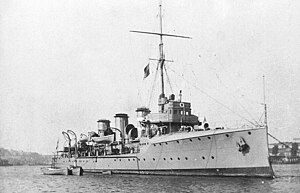HMS Patrol (1904)
This article includes a list of references, related reading, or external links, but its sources remain unclear because it lacks inline citations. (April 2009) |
 With original 12-pounder guns
| |
| History | |
|---|---|
| Name | HMS Patrol |
| Builder | Cammell Laird, Birkenhead |
| Laid down | October 1903 |
| Launched | 13 October 1904 |
| Commissioned | September 1905 |
| Decommissioned | 1919 |
| Fate | Sold for scrap, 21 April 1920 |
| General characteristics (as built) | |
| Type | Scout cruiser |
| Displacement | 2,940 long tons (2,987 t) |
| Length | 370 ft (112.8 m) (p/p) |
| Beam | 38 ft 9 in (11.8 m) |
| Draught | 15 ft 2 in (4.6 m) (deep load) |
| Installed power |
|
| Propulsion | 2 Shafts, 2 triple-expansion steam engines |
| Speed | 25 knots (46 km/h; 29 mph) |
| Complement | 289 |
| Armament | |
| Armour |
|
HMS Patrol was a Template:Sclass- scout cruiser which served with the Royal Navy before and during the First World War. She has been the only ship of the Royal Navy to bear the name HMS Patrol.
Design
To save weight and increase her speed she sported a partially armoured deck, with side armour protecting the engine rooms, rather than the standard protective deck of most cruisers. Speed was the key as she was designed to work with the destroyer flotillas. She was built at yards of Cammell Laird, where she was laid down in October 1903 and completed in September 1905 at a cost of around £279,000. She carried a full complement of 268 officers and men. Originally armed with ten 12 pounder and eight three pounder guns with two 18inch torpedo tubes mounted above the water, she was upgraded with nine 4 inch guns and six 6 pounder guns in 1911/12.
Career
She joined the Home Fleet in October 1907 and then the 3rd Fleet at the Nore Command in 1908. In 1909 she served a short spell as leader of the 1st Destroyer Flotilla at Portsmouth, then moved to the 3rd Flotilla and then the 1st in 1910. In 1911 she was stationed at Harwich with the 1st Flotilla under Captain Francis M Leake. In 1913–14 she was stationed at Haulbowline, a naval base in Cork and now the headquarters of the Irish Navy.
At the onset of the First World War Patrol was part of the 9th Destroyer Flotilla, protecting the north east coastline between the Firth of Forth and the Tyne. On 15 December, under the command of Captain Alan C. Bruce, she was berthed in Hartlepool with HMS Forward, another scout cruiser, four destroyers from the 9th Flotilla (HMS Doon, HMS Waveney, HMS Moy and HMS Test) and the submarine HMS C9.
On 16 December, the destroyers put out to sea at 5.30 a.m. without the protection of the cruisers due to a heavy swell outside the tidal port. At 8 a.m. the flotilla sighted the German battlecruisers Seydlitz and Moltke and the cruiser Blücher, intent on a raid on Hartlepool. The heavy German ships chased off the hopelessly outgunned destroyers and opened fire on Hartlepool's two gun batteries, which mounted three six-inch guns, before bombarding the port and harbour entrance.
Captain Bruce attempted to dash out to sea but was sighted by the Blücher and hit by two heavy shells at around a quarter to nine. Four men were killed and seven wounded, and the ship ran aground on the entrance to the Tees. She was saved from destruction by the German ships breaking off the raid to make back to the open sea. Badly holed and taking on water, the Patrol was lying too low to return to Hartlepool but was able to struggle into Middlesbrough docks.
After undergoing extensive repairs she joined the 7th Destroyer Flotilla in the Humber in 1915. She was transferred to the Irish Sea in 1918 and then back to the 9th Destroyer Flotilla at the Nore. Surplus to requirements after the end of the war, she was paid off in 1919 and sold for scrap on 21 April 1920 to Machinehandel, of the Netherlands.
Notes
- ^ "Cwt" is the abbreviation for hundredweight, 18 cwt referring to the weight of the gun.
Footnotes
Bibliography
- Chesneau, Roger; Kolesnik, Eugene M., eds. (1979). Conway's All the World's Fighting Ships 1860–1905. Greenwich: Conway Maritime Press. ISBN 0-8317-0302-4.
{{cite book}}: Unknown parameter|lastauthoramp=ignored (|name-list-style=suggested) (help) - Corbett, Julian. Naval Operations to the Battle of the Falklands. History of the Great War: Based on Official Documents. Vol. I (2nd, reprint of the 1938 ed.). London and Nashville, Tennessee: Imperial War Museum and Battery Press. ISBN 0-89839-256-X.
- Friedman, Norman (2009). British Destroyers From Earliest Days to the Second World War. Annapolis, Maryland: Naval Institute Press. ISBN 978-1-59114-081-8.
- Friedman, Norman (2011). Naval Weapons of World War One. Barnsley, South Yorkshire, UK: Seaforth. ISBN 978-1-84832-100-7.
- Gardiner, Robert; Gray, Randal, eds. (1984). Conway's All the World's Fighting Ships: 1906–1921. Annapolis, Maryland: Naval Institute Press. ISBN 0-85177-245-5.
{{cite book}}: Unknown parameter|lastauthoramp=ignored (|name-list-style=suggested) (help)
